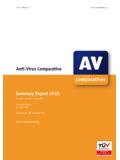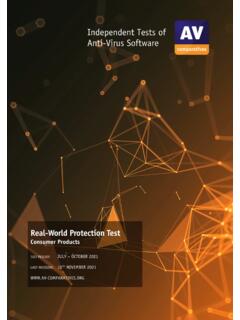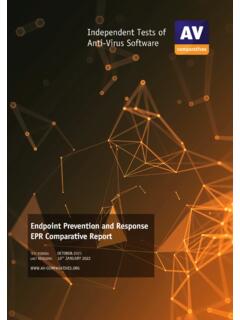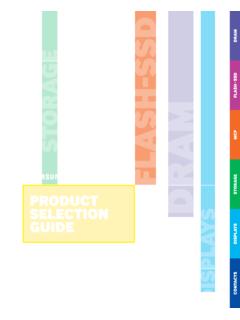Transcription of Anti-Spam Test Consumer 2016 - av-comparatives.org
1 Anti-Spam Test Anti-Spam Test ( Consumer Products) Language: English March 2016 Last Revision: 20th April 2016 Commissioned by PC Magazin AV-Comparatives Anti-Spam Test 2016 - 2 - Table of Contents Tested Products 3 Introduction 4 Test procedure 5 Results 8 AV-Comparatives Spam Map 9 Product reviews 10 Copyright and Disclaimer 33 AV-Comparatives Anti-Spam Test 2016 - 3 - The following products were tested in March 2016 for their ability to filter out spam emails. We always used the most up-to-date product version available. The selection of tested products is based on suggestions by the German computer magazine PC Magazin. Avast Internet Security 2016 AVG Internet Security 2016 Bitdefender Internet Security 2016 BullGuard Internet Security ESET Smart Security F-Secure Internet Security 2016 G Data Internet Security 2016 Kaspersky Internet Security 2016 Lavasoft Ad-Aware Pro Security McAfee Internet Security 2016 Microsoft Outlook 2013 SuperSpamKiller Pro Symantec Norton Security Tested Products AV-Comparatives Anti-Spam Test 2016 - 4 - Introduction Spam can be defined as unsolicited emails sent en masse1.
2 These may be sent for advertising purposes, in which case they may be seen as irritating but harmless. However, many spam mails are clearly malicious. They may attempt to deceive the recipient into sending money to the scammer; typical examples are pretending to be a friend or relative who has lost their wallet while abroad, and so needs money to get home, or claiming that by paying a relatively small administration fee, the recipient will receive a much larger sum as lottery winnings. Other malicious spam emails may contain links to phishing pages or malware, or simply include malware as an attachment. The Spamhaus Project explains the difference between spam and legitimate bulk email2. Users should note that not all emails they regard as unwanted can necessarily be defined as spam. We ensured that all the mails used in our test are indisputably spam, please see details of the test procedure below.
3 Research by Kaspersky Lab in 20123 suggested that overall spam might be falling due to an increase in legal advertising opportunities on the web, resulting in a reduction of non-malicious advertising spam. Recent research by Trend Micro4 finds a more sinister reason for the reduction in overall spam levels. It suggests that malicious spam mails are now being more carefully targeted at specific known addresses, rather than using an email address generator that will produce huge numbers of potential email addresses, many of which will not actually exist in practice. Another 2015 report, in this case from Symantec5, notes that spam affecting business users is currently at a 12-year low. Whilst this sounds encouraging, we note that the analysis is based on the percentage of all emails received by business that have been classified as spam; this might mean that fewer spam mails have been sent, or that more legitimate mails have been sent, or some combination of the two.
4 The aim of this test is to provide readers with a guide to the effectiveness of some popular Consumer programs with antispam features. Please consider the following limitations of the test, which focuses only on the spam-filtering capabilities of the products tested. It does not consider any other features of the products (such as malware detection); however, as 12 of the 13 products tested include malware protection, it is possible that some spam mails containing malware attachments were deleted by a product s antimalware feature before they could be marked as spam. The test was performed in March 2016 under Microsoft Windows 7 SP1 64-Bit (English), using Microsoft Outlook 2013 as the email client. Over 127,000 spam mails were used for this test. 1 2 3 #2 4 5 AV-Comparatives Anti-Spam Test 2016 - 5 - Test procedure In 2015 , we tested the products (with default settings) internally over a 6-month period, using spam mails provided by Abusix6.
5 Vendors received examples of misses, to check that our testing methods work, and to provide feedback. Several products had very low scores in the internal test run, and several bugs in the spam-filters and products were discovered and had to be fixed by the vendors. In some cases, poorly-performing third-party spam-filters were fixed or even replaced. In March 2016 , we ran this public test. With any detection test (including spam detection), it is important to test for false alarms. In this case, it should be considered that some programs automatically increase their sensitivity when spam mails make up a large percentage of total mails received. We conducted a short-term false alarm test for this report, by running each product for one week on a customer machine and inspecting afterwards if there were legitimate mails classified wrongly as spam (there were none for any of the products tested).
6 A large-scale test with genuine emails would be impossible without breaching privacy; although this was not as statistically significant as we would like, we feel this was sufficient to demonstrate that none of the tested programs was prone to FPs. In the review of each program, we have checked to see if it adds its own tools to the Outlook ribbon, whether any configuration is needed to activate the antispam component, and what settings can be changed. We also looked for an option to clean the Inbox of any spam mails that were received before the product was installed/activated. Readers should note the following points: We tested Consumer products (almost all other antispam tests involve corporate antispam software) The products we tested were not allowed any form of training We disabled Outlook s own spam-filtering feature on test machines running an additional antispam product Any pre-filtering done by email-service providers (like Gmail, Yahoo, etc.)
7 Is not taken into account Overview 6 AV-Comparatives Anti-Spam Test 2016 - 6 - Environment Each product receives emails from a POP3 mailbox (one mailbox per product, exclusive access). The products can use the domain and IP-address information in the received header of each mail; however, as the emails are provided by one SMTP relay with a fixed IP address, the address of the relay cannot be used for spam filtering. Sent Emails Emails are collected and transferred by Abusix. The spam feed is then pre-filtered (only valid emails are taken). All emails are forwarded without any changes to the main text, but the headers are rewritten, so that it appears to the receiver that the mail has been sent directly. The original recipient is replaced by the email address of the tested product, such as "Recipient All other fields remain untouched and are used as they come from the spam traps.
8 Mails which had corrupted headers etc. for whatever reason were not counted in the results. Some of the emails in the Abusix spam feed have been anonymized ( : or Such emails are also not used for testing. Only emails from senders with a full and valid email address are taken for the test. We also removed emails which did not contain at least one Received field with an IP address in the header. After filtering, the resulting set of emails is larger than is required for the test; mails for the feed are selected at random at the rate of one every three minutes. Additionally, the following lines will be added by the intermediate mail server: Delivered-To: X-Original-To: Return-Path: Received: from localhost (internal_domain [ ]) by (Postfix) with ESMTP id unique_id for Thu, 13 Feb 2014 16:33:51 +0100 (CET) The following conditions apply: Product ID.)
9 Unique ID for each participating product. internal_server .. the hostname of the mail server internal_domain .. the domain to which the mails will be delivered unique_id .. unique id for each mail (will be generated by the mail server) Timestamp in the "received header" .. the time the mail is received by the mail server 127,800 spam mails have been used for this one-week test. AV-Comparatives Anti-Spam Test 2016 - 7 - Sources of spam emails The spam mails for this test were provided by Abusix, who provide the following explanation of their spam-collecting procedure7: Abusix has a huge network with several domains and thousands of email accounts. The spamtraps we generate within this network are administrated entirely by us. We do not use traps from other parties. The email addresses and the domains have never been used for any purpose other than for traps.
10 No signups or subscriptions have ever been made with these addresses. Therefore, every email that hits these traps is a 100% spam. Senders that send to these addresses have likely found the domains registered within the domain whois, and then automatically created a range of similar email addresses, and started to send. This spam technique used by spammers is called dictionary attack . Another way we use to spread email addresses are different types of harvester techniques. Regardless of the method, both identify non-permitted spam behavior in a precise and reliable manner. Future tests Home Users Several vendors are thinking of removing the antispam feature from their Consumer security products, as nowadays most users make use of webmail or mobile apps, and most antispam products/components work only with dedicated desktop email clients (SuperSpamKiller Pro is the only exception amongst the products in our test).








